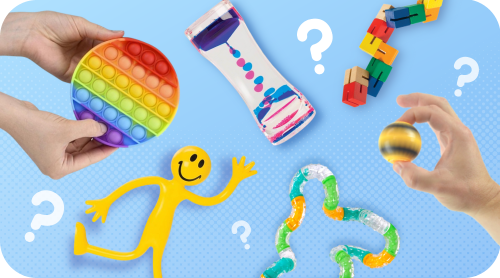What is a Sensory Toy and How Can they Help?
Posted by Bonnie Arnwine on Apr 28th 2023

Sensory toys, my family loves them and so do I. I love sensory based play because it is beneficial for all children and it's lots of fun.
What is a sensory toy?
Sensory toys come in many different forms, from soft textured balls and fidget toys to musical instruments and sensory bins filled with different types of materials. They are enjoyable for all children, as they provide a fun and engaging way to explore and learn about the world.
What are the benefits of sensory toys?
Along with sensory development sensory toys can help with cognitive development. These toys are excellent for teaching cause-and-effect relationships, problem-solving skills, and how to process information. For example, a child playing with a noise making item, like a Klickity, can learn that their actions can effect their environment- when they move the toy they make sound. When they stop moving the toy it is quiet.
Sensory toys can also help with social and language development. You can use them to teach descriptive words such as soft, hard, bumpy, squishy, colors, loud, bright, blink, and more. These types of toys can also teach taking turns (first I use the bubble gun, now it’s your turn), sharing (playing together in a sand and water table), and cooperation (let’s pull the toys out of the putty together).
Many sensory toys also help develop fine motor skills, which involve the use of small muscles in the hands and fingers. For example, a child playing with a toy that requires squeezing, grasping, or manipulating small objects can help to improve their hand-eye coordination, dexterity, and strength. This kind of play is important for writing, drawing, and using utensils.
Things to Consider Before Introducing a Sensory Toy
There are several things to consider when choosing a sensory toy. Different sensory toys may be appropriate for different age ranges. While older students may enjoy toys designed for toddlers, if at all possible try to find age appropriate options. Fortunately, today there are many developmentally appropriate fidgets and other sensory toys for older kids and adults.
Individuals with sensory processing difficulties may have specific preferences for certain types of sensory input, such as visual, auditory, tactile, or proprioceptive stimulation. It can be helpful to observe the child's behavior and interests to identify their preferred sensory experiences. For example, a child who enjoys playing with sand may benefit from a sensory bin filled with different types of sensory materials. Conversely, a child who is sound sensitive may have difficulty with a sound toy that does not have the option to modulate the sound level.
Sensory toys that provide multiple sensory experiences can be particularly beneficial, as they can help to support overall sensory integration and processing skills. For example, a musical instrument can provide both auditory and tactile stimulation. Be careful with multisensory toys- too much stimulation can overwhelm a child’s senses. Finally, also, consider the durability of the toy, as sensory toys may be subjected to heavy use and wear.
Children learn through play. While introducing sensory toys remember to be patient with the sensory sensitive supportive, keep it interesting, and don't forget to have lots of fun.
Bonnie Arnwine is on the advisory board for National Autism Resources and the author of Starting Sensory Therapy: Fun Activities for Your Home and Classroom.
References:
Abidin, Anis Sofia Zainal, et al. "Significance of Sensory Activities among Toddlers for Sensory Skills Development." Environment-Behaviour Proceedings Journal 7.SI7 (2022): 15-27.
Dunbar, Sandra Barker, et al. "A pilot study comparison of sensory integration treatment and integrated preschool activities for children with autism." Internet Journal of Allied Health Sciences and Practice 10.3 (2012): 6.
Maynard, Christine N., et al. "An examination of the effects of teacher intervention during sensory play on the emotional development of preschoolers." Family and Consumer Sciences Research Journal 38.1 (2009): 26-35.
Miller, Lucy Jane. Sensational kids: Hope and help for children with sensory processing disorder (SPD). Penguin, 2014.
Schoen, Sarah A., et al. "A systematic review of Ayres sensory integration intervention for children with autism." Autism Research 12.1 (2019): 6-19.







